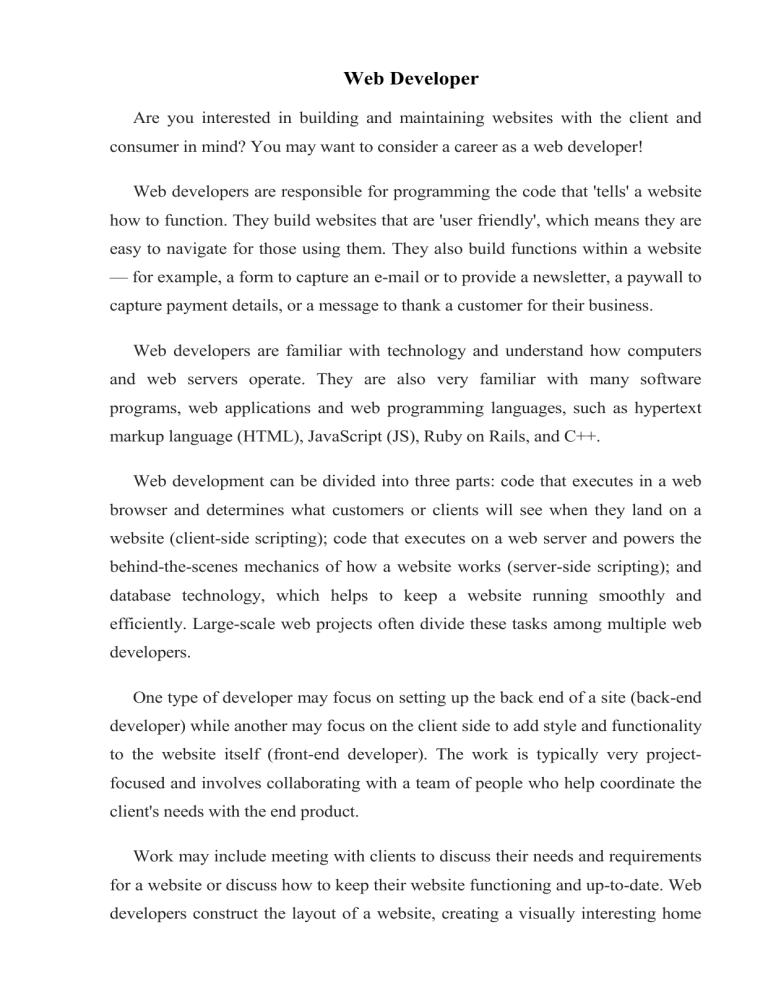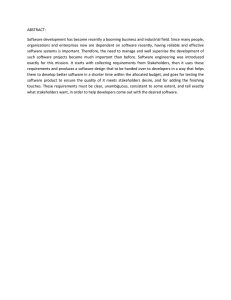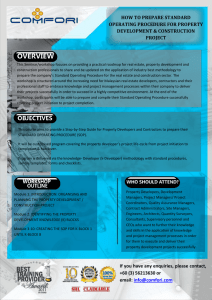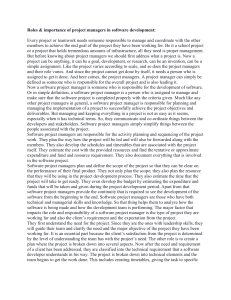
Web Developer Are you interested in building and maintaining websites with the client and consumer in mind? You may want to consider a career as a web developer! Web developers are responsible for programming the code that 'tells' a website how to function. They build websites that are 'user friendly', which means they are easy to navigate for those using them. They also build functions within a website — for example, a form to capture an e-mail or to provide a newsletter, a paywall to capture payment details, or a message to thank a customer for their business. Web developers are familiar with technology and understand how computers and web servers operate. They are also very familiar with many software programs, web applications and web programming languages, such as hypertext markup language (HTML), JavaScript (JS), Ruby on Rails, and C++. Web development can be divided into three parts: code that executes in a web browser and determines what customers or clients will see when they land on a website (client-side scripting); code that executes on a web server and powers the behind-the-scenes mechanics of how a website works (server-side scripting); and database technology, which helps to keep a website running smoothly and efficiently. Large-scale web projects often divide these tasks among multiple web developers. One type of developer may focus on setting up the back end of a site (back-end developer) while another may focus on the client side to add style and functionality to the website itself (front-end developer). The work is typically very projectfocused and involves collaborating with a team of people who help coordinate the client's needs with the end product. Work may include meeting with clients to discuss their needs and requirements for a website or discuss how to keep their website functioning and up-to-date. Web developers construct the layout of a website, creating a visually interesting home page and user-friendly design, and may sometimes write content for the website. After a website is up and running, developers ensure the site is functional on all web browsers, testing and updating as needed. Types of web developers: Front-End Developers A front-end developer codes the front end of a website. While web design is the way a website looks, front end development is how that design gets implemented on the web. By integrating markup languages, design, scripts and frameworks, front-end developers create the environment for everything that users see, click, and touch. These are the Front-End Languages: HTML, CSS, and in some years ago JavaScript. CSS has some frameworks. One of the popular framework is Bootstrap. If you are interested in Front-End, you have definitely heard something about SASS, SCSS and LESS. These are the languages that allow CSS code to be written in a simpler and easier way. In addition, the loss of time is little. Back-End Developers A back-end developer builds and maintains the technology needed to power the components which enable the user-facing side of a website to exist. Their back end code adds utility to everything the front-end designer creates. These are the some popular Back-End languages: JavaScript, Node JS, Ruby, PHP, C#, Java and Rust. As I mentioned in the previous section, JavaScript is already considered as a backend language. The most notable of these is Python. Because Python is the most widely used programming language in recent years. The reason is that this language is easier and shorter to write than other languages. Its syntax is basic. Therefore, beginners are advised to learn Python firstly. Rust is a relatively new language that has not been there for more than 10 years. It follows the same syntax that C++ uses. In here one of the old language is PHP. Most of the developers no longer use this language. Full Stack Developers Full stack developers understand how every part of the web development process takes place and can guide on strategy and best practices. These developers will have an increasingly important role in the web development of the future, and are able to look at the 'big picture'. They are knowledgeable with the server side as well as the client side’s user experience. If you want to be a successful Full-Stack developer, you should make a strong road map. To become a full-stack developer, you must have strong experience in this field for about 5 years. Even if you are a full-stack developer, you need to be open to innovations and develop yourself every day. JavaScript Developers JavaScript (JS) is a type of web programming language that is supported across all web browsers and tools, and is the language that gives JavaScript developers control and power to create, enhance and modify websites. Even though a JavaScript developer typically works on the front-end, the programming language itself is not limited to front-end use only. How has Covid-19 affected the industry? While many industries have struggled and as a result of the coronavirus pandemic, the tech industry has fared relatively well. Many organizations are relying on digital tools to enable them to operate remotely, placing even more importance on technology and the people who build it. As such, many are anticipating an industry boom: according to Market Data Forecast, the tech industry will grow from $131 billion USD in 2020 to $295 billion in 2025. Of course, new and aspiring web developers can expect some changes as a result of Covid-19. First and foremost, it’s important to consider the rise of remote work. When it comes to looking for your first job within the field, you should be prepared to work remotely at least some of the time, if not on a full-time basis. Fortunately, web development is a career that lends itself to remote work. We’re also anticipating that web developer jobs will increase in certain sectors as a direct result of the products and services that are most in-demand right now. For example, sectors like healthcare, media and entertainment, online banking, remote education, and e-commerce will continue to grow to reflect consumer needs and behaviors in a more socially-distant world. In all, the impact of Covid-19 on the tech industry, and on web developers, has been minimal compared to other sectors. Although the situation is still unfolding, new and aspiring web developers can feel confident that they’re embarking on a future-proof career. If you’re curious as to what it’s like to be a newly-qualified tech graduate in the midst of a pandemic, take a look at our guide to job searching during Covid-19. In it, Mike McCulloch, Head of Career Services at Career Foundry, shares his observations of the tech job market, together with some great advice on how to market yourself as a newcomer to the field. Client-side Client-side scripting, or frontend development, refers to everything that the end user experiences directly. Client-side code executes in a web browser and directly relates to what people see when they visit a website. Things like layout, fonts, colors, menus and contact forms are all driven by the frontend. Server-side Server-side scripting, or backend development, is all about what goes on behind the scenes. The backend is essentially the part of a website that the user doesn’t actually see. It is responsible for storing and organizing data, and ensuring that everything on the client-side runs smoothly. It does this by communicating with the frontend. Whenever something happens on the client-side—say, a user fills out a form— the browser sends a request to the server-side. The server-side “responds” with relevant information in the form of frontend code that the browser can then interpret and display. Learn more: What’s the difference between frontend and backend? Database technology Websites also rely on database technology. The database contains all the files and content that are necessary for a website to function, storing it in such a way that makes it easy to retrieve, organize, edit, and save. The database runs on a server, and most websites typically use some form of relational database management system (RDBMS). To summarize: the frontend, backend, and database technology all work together to build and run a fully functional website or application, and these three layers form the foundation of web development. The difference between web development and web design You might hear the terms web development and web design used interchangeably, but these are two very different things. Imagine a web designer and web developer working together to build a car: the developer would take care of all the functional components, like the engine, the wheels and the gears, while the designer would be responsible for both the visual aspects—how the car looks, the layout of the dashboard, the design of the seats— and for the user experience provided by the car, so whether or not it’s a smooth drive. Web designers design how the website looks and feels. They model the layout of the website, making sure it’s logical, user-friendly and pleasant to use. They consider all the different visual elements: what color schemes and fonts will be used? What buttons, drop-down menus and scrollbars should be included, and where? Which interactive touchpoints does the user interact with to get from point A to B? Web design also considers the information architecture of the website, establishing what content will be included and where it should be placed. References: https://www.marketdataforecast.com/blog/impacts-of-covid19-on-informationtechnology-industry https://careerfoundry.com/en/magazine/job-searching-covid-19/ www.careerexplorer.com/careers/fr https://www.careerexplorer.com/careers/back-end-developer/ https://www.careerexplorer.com/careers/full-stack-developer/ https://www.careerexplorer.com/careers/javascript-developer/


